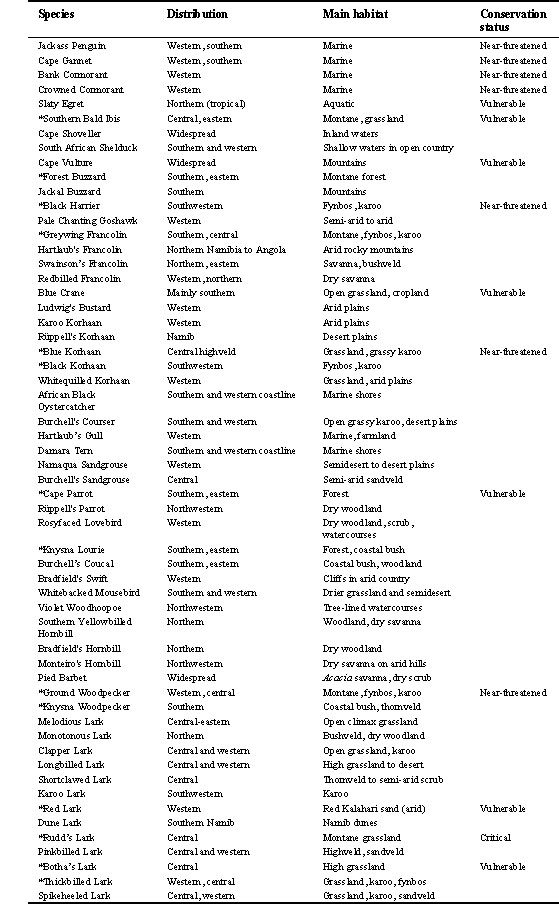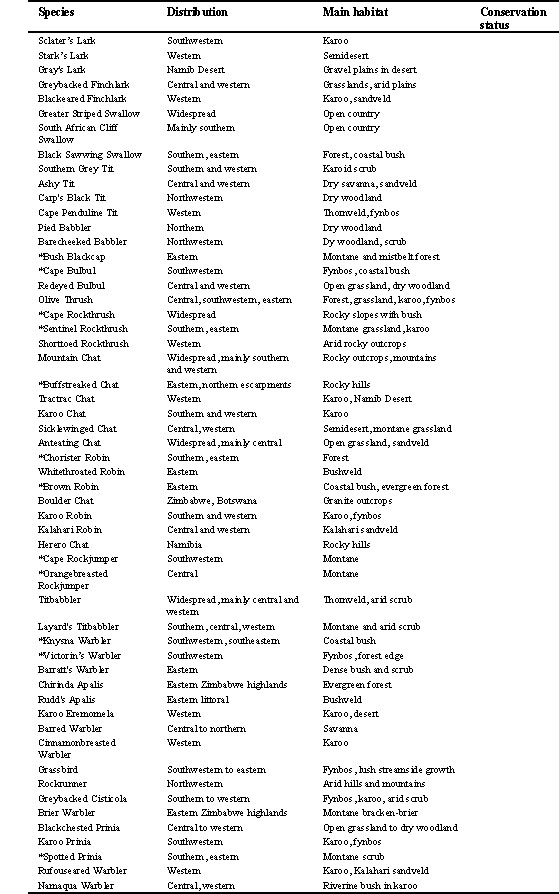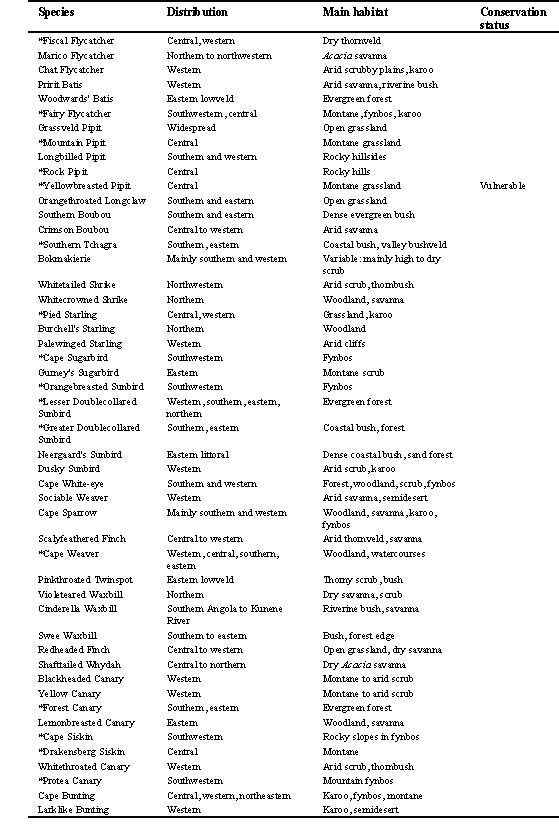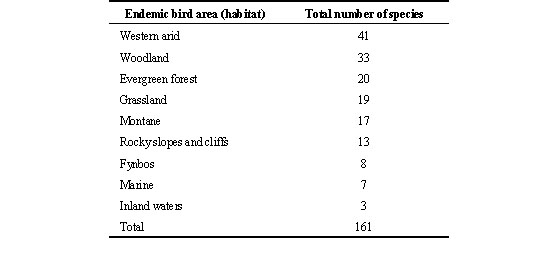
Southern African endemic birds: Their distribution and conservation
Gordon L. Maclean
PO Box 127, Rosetta, 3301, South Africa, e-mail Maclean@futurest.co.za
Maclean, G.L. 1999. Southern African endemic birds: Their distribution and conservation. An invited evening public lecture. (lxiii-lxxviii)
Of the 928 species of birds currently on the southern African list (Harrison et al. 1997), 161 (17.3%) are endemic or nearly endemic to southern Africa. Of these, 43 (4.6% of the total, 26.7% of the endemics) are endemic to South Africa (including Lesotho). These endemic species occur in 13 habitat categories or biomes; some species extend over two or more biomes, but none over more than four. The biome with the largest number of endemic species is the Western Arid region with 41 species. Only nine species of birds endemic to southern Africa are considered threatened (Collar et al. 1994): one is critical, four are vulnerable and four are near-threatened. The conservation future of most of the endemic species is reasonably assured by virtue of protection in one or more reserves or by virtue of remoteness. The southern African reserve with the largest number of endemics is the Mountain Zebra National Park with 34 species; this reserve deserves special recognition for its role in the conservation of avian biodiversity in southern Africa.
Introduction
Of the 928 species of birds on the southern African bird list (Harrison et al. 1997), 161 (17.3%) are endemic to the Southern African Subregion (Fig. 1), that is the region south of the Kunene and Zambezi Rivers, making allowance for a few species which extend along the Namib littoral into southwestern Angola (Appendix 1). These include 43 species endemic or nearly endemic to South Africa (including Lesotho for practical reasons), a few of which occur on the northern bank of the Orange River and perhaps slightly further into Namibia, such as the Cape Francolin Francolinus capensis (Fig. 2). Some others migrate into Namibia and Botswana (examples here are the Black Harrier Circus maurus and the Fairy Flycatcher Stenostira scita (Fig. 3)
), but their breeding areas are entirely within the borders of South Africa. These 43 species form 4.6% of the southern African total and 26.7% of the southern African endemics.The purpose of this review is to determine the major areas of endemism in southern Africa and to make a rough assessment of the conservation status of the endemic birds of the region.
Birds and Biomes
The main distributions of southern Africa’s endemic birds fall into 16 definable habitat categories or biomes (given in Appendix 1), the main seven of which are shown in Fig. 1. These 16 categories may be consolidated into nine categories as shown in Table 1, which also gives the number of species in each.
Highveld-to-dryveld
Most endemic bird species can easily be placed in one habitat type (or two at most), but there is a widely distributed group of 22 species of birds which I refer to as ‘highveld-to-dryveld’, six of them endemic to South Africa, and a further 16 spreading from Lesotho and the Free State right across the dry west into Namibia and even Botswana. The birds of this group are spread across three or four habitat types including Western Arid, Grassland, Montane and Fynbos (Table 1; Fig. 1). Examples of this group are the Thickbilled Lark Galerida magnirostris (Fig. 4a), Longbilled Lark Mirafra curvirostris (Fig. 4b), Burchell's Courser Cursorius rufus (Fig. 5), Sicklewinged Chat Cercomela sinuata (Fig. 6) and Mountain Chat Oenanthe monticola. Even some of the large Western Arid group of 41 species of birds, adapted mainly to the arid zones of the Karoo, Namib and intermediate regions, fall into the ‘highveld-to-dryveld’ category, while other ‘highveld-to-dryveld’ birds are included in the Montane (= Afroalpine) and Grassland groups, since it is not always easy to decide whether a species is primarily arid-adapted or montane. Arid, dry-grassland and montane habitats share many ecological features, hence the occurrence of so many species across these biomes.
Western Arid (including the Karoo)
Much of the arid west tends to look after itself in conservation terms, but overstocking has led to considerable degradation of the environment, to the detriment of its birds. Perhaps the most vulnerable species are the large ones, like Ludwig's Bustard Neotis ludwigii, which suffer not only from habitat loss, but also from disturbance by people and domestic stock. Drought influences these regions adversely too, since it aggravates the damage already done to this fragile environment by overstocking. Large parts of the arid west are under proper conservation management, such as the Kalahari Gemsbok National Park in the sandveld, the Mountain Zebra, Karoo and Tanqua-Karoo National Parks in the Karoo, and most of the Namib Desert in Namibia, so that the future of the birdlife in these regions is quite well assured. This is of particular importance to biodiversity in the light of the fact that new techniques are revealing possible new taxa, especially among the more sedentary species of larks (Ryan 1996).
Until relatively recently, one of the least adequately conserved biomes in South Africa has been the Karoo. Most of it is under domestic stock which has caused major degradation of the habitat, but fortunately there are two major reserves (Mountain Zebra National Park and the Karoo National Park) where Karoo birds find a safe haven. No fewer than 34 southern African endemics occur in Mountain Zebra National Park alone: of these, 13 are almost entirely South African, namely Ground Woodpecker Geocolaptes olivaceus, Thickbilled Lark (Fig. 4a), Cape Rockthrush Monticola rupestris, Sentinel Rockthrush M. explorator, Sicklewinged Chat (Fig. 6), Orangebreasted Rockjumper Chaetops aurantius (Fig. 17), Namaqua Warbler Phragmacia substriata (Fig. 7), Fiscal Flycatcher Sigelus silens, Rock Pipit Anthus crenatus, Southern Tchagra Tchagra tchagra, Pied Starling Spreo bicolor, Lesser Doublecollared Sunbird Nectarinia chalybea (Fig. 8) and Cape Weaver Ploceus capensis. Whether these parks are going to prove large enough in the long run to be viable centres of conservation for the flora and fauna contained within them, remains to be seen. For the rest, the establishment of conservancies on privately owned farmland means hope for the future, but conservation in the Karoo is still at an early stage of development.
In the Karoo proper, as distinct from the other arid to semi-arid habitats, there are 17 endemics, of which two are almost entirely South African, the Namaqua Warbler (Fig. 7) and the Fiscal Flycatcher. The rest extend well into Namibia, the southern parts of which are largely Karoo in nature. The Karoo is a highly degraded habitat as a result of overgrazing by stock, but the effect of this on the birdlife has not been measured. A species which has probably suffered most from this degradation is the more widespread Burchell’s Courser (Fig. 5) whose decline is well documented.
Grassland
The birds of the grasslands of the Central Highlands, such as the Blue Korhaan Eupodotis caerulescens (Fig. 9), Bald Ibis Geronticus calvus, Rudd's Lark Heteromirafra ruddi (Fig. 10) and Botha's Lark Spizocorys fringillaris (Fig. 11) find themselves in conflict with the agricultural endeavours of humankind. There are no adequate reserves for the conservation of any of these species, especially the korhaan and the two larks: they occur mainly on agricultural land, whether for grazing or crop growing, and they survive more by default than because of any active conservation measures. The Bald Ibis is somewhat better off since it is conspicuous, has a correspondingly high profile and is therefore well known as a conservation priority by members of the public; though it forages largely in farmland, some of its breeding sites are fortunately also in conservation areas of KwaZulu-Natal.
The strictly grassland birds of the Central Highlands (or Highveld, a region of open Grassland and Montane or sub-Montane habitats) are almost completely isolated from the rest of southern Africa, because of the increasing aridity to the west and increasing moisture and woodland to the east, aggravated by decreasing altitude towards the Indian Ocean coastline, which is accompanied by subtropical conditions. As mentioned above, the most closely restricted species to this biome are the Blue Korhaan , Rudd's Lark and Botha's Lark. All three of these species are listed as threatened by Collar et al. (1994): The Blue Korhaan is Near-threatened, Rudd’s Lark is Critical and Botha’s Lark is Vulnerable. South Africa’s grasslands have been described as the ‘Cinderella biome’, the impact of man on which is considered to have been more devastating than on any other of the world’s biomes (Tarboton 1997a).
No fewer than seven of the IUCN Red Data species of South African birds are entirely restricted to grassland; of these, five are endemic to southern Africa. The main threats to the grasslands are destruction of habitat by urbanisation, ‘afforestation’ (the planting of exotic timber trees) and mining, in addition to agro-poisoning, and air pollution by coal-burning power stations, which produces acid rain (Tarboton 1997b). Of all state-owned conservation land in South Africa, 64% falls within the savanna biome, and only 2.2% in grassland (Tarboton 1997c); within the grassland, however, there is no formal conservation for Botha’s Lark, and no prospect of its particular veld type coming under such control. Conservation of most grassland birds therefore depends on ‘ordinary people who care’ (Tarboton 1997c).
Montane
The montane habitats have a certain measure of protection in KwaZulu-Natal in that they fall into the jurisdiction of the KwaZulu-Natal Conservation Services, but the rest of this biome is poorly conserved. Much of it belongs to commercial forestry companies which are growing increasing amounts of exotic timber below the Afroalpine zone, to the detriment of both the montane grasslands and the escarpment forests.
No endemic species of southern African birds are confined strictly to the Afroalpine zone at the top of the Montane region: most of them fall into the ‘Highveld-to-dryveld’ group already mentioned, while others extend into neighbouring grasslands to some extent. A few, such as the Fairy Flycatcher and the Greybacked Cisticola, occur also in Fynbos. A few other species have fynbos representatives with which they form sibling species (see below under Fynbos).
Evergreen forest
It is not always possible to separate birds of the lowland to midland evergreen bush and forest into a purely southern distribution and a purely eastern distribution, since several are spread across these two regions. It is often equally hard to distinguish between coastal bush and evergreen forest, which is why I have grouped them together in Table 1. as ‘Evergreen forest’. Distinctions are further blurred by altitudinal migration of some bird species in the evergreen-forest category (Johnson & Maclean 1994). Of six South African endemics, four (Bush Blackcap Lioptilus nigricapillus, Chorister Robin Cossypha dichroa (Fig. 12), Brown Robin Erythropygia signata and Forest Canary Serinus scotops) are almost entirely ‘eastern’, ranging from just west of Port Elizabeth up towards the Transvaal Drakensberg escarpment or even into the Soutpansberg. Even more strictly ‘eastern’ and confined to the evergreen littoral bush and forest from northern KwaZulu-Natal to Mozambique are Rudd’s Apalis Apalis ruddi, Woodwards’ Batis Batis fratrum and Neergaard’s Sunbird Nectarinia neergaardi (Fig. 13). The Knysna Warbler Bradypterus sylvaticus (Fig. 14) is an exclusively ‘southern’ species, while the Lesser Doublecollared Sunbird (Fig. 8) ranges widely from the Succulent Karoo (a non-forest habitat) of Namaqualand in the extreme west, through the fynbos, all the way up to the Soutpansberg.
The relatively small number of forest endemics (20 species) in southern Africa reflects the fragmented nature of the forests in the region, as well as their highly variable history through geological time. During the Pleistocene era, the past two million years or so, dry-and-cool alternated with wet-and-warm periods, resulting in alternate expansion and contraction of the forested regions of the whole African continent. Apart from that, the forests of South Africa cover a mere 2 500 km2 altogether (Geldenhuys 1989), which is very small compared with other biomes.
Indigenous forests in South Africa have suffered badly under the old systems of logging for high-quality timber, and invasion by alien trees, but they are increasingly being seen as areas worth protecting for their intrinsic value as refuges of some endangered forest-dependent bird species. Fortunately, some of our forest birds have adapted to suburban habitats and survive well outside of their native forests: examples are the Olive Thrush Turdus olivaceus (Fig. 15), Chorister Robin, Cape Batis Batis capensis, Lesser Doublecollared Sunbird and Forest Canary. This is true also of most of the birds endemic to lowland and other bush habitats, such as the Southern Boubou Laniarius ferrugineus and Southern Tchagra, to name but two of the southern African endemics.
Marine
The seven southern African marine endemics (Appendix 1) are largely cold-water species whose main populations occur on the west coast where the cold Benguela Current washes the food-rich coastline. Threats to these species include oil pollution, overfishing, harvesting of guano and, in the case of the shoreline dwellers such as the African Black Oystercatcher Haematopus moquini, human disturbance, especially on sandy beaches.
Fynbos
The Cape fynbos, with its eight endemic species of birds, is being rapidly destroyed to make way for agriculture. Although more than half of the Mountain Fynbos is protected and about 89% of the original area remains intact, only about 17% of the total fynbos biome was under conservation in 1986, but up to 27.5% in 1992; things therefore look rather better, but there is a long way to go yet. Regions especially poorly conserved include the coastal components of strandveld, renosterveld and coastal fynbos, probably because these regions are given over to farming and other human endeavours. Only 3% of the renosterveld is preserved and only 15% of the total original area of this subhabitat remains intact. In 1986 there were 12 nature reserves measuring a total of 51 099 hectares in area and four wilderness areas measuring 123 115 hectares in area (van Rensburg, undated).The fynbos is not only floristically unique in the world, but is isolated from the rest of the major African biomes by semidesert, grassland and the summer-rainfall regime of the more easterly parts of southern Africa. The central massif of South Africa is likewise isolated and harbours some species which form eastern counterparts of their fynbos relatives: examples are the Cape Siskin Pseudochloroptila totta and Drakensberg Siskin P. symonsi (Fig. 16), Cape Rockjumper Chaetops frenatus and Orangebreasted Rockjumper C. aurantius (Fig. 17), Karoo Prinia Prinia maculosa and Spotted Prinia P. hypoxantha, and Cape Sugarbird Promerops cafer and Gurney's Sugarbird (Fig. 18).
South Africa as a Centre of Endemism
If political boundaries were not a consideration, to some of the species regarded in this article as almost purely South African could be added a few more which extend rather further into Namibia and/or Botswana. These include the Shortclawed Lark Mirafra chuana and the mainly Karoo endemics: Karoo Lark Mirafra albescens, Sclater's Lark Spizocorys sclateri, Blackeared Finchlark Eremopterix australis, Karoo Robin Erythropygia coryphaeus (Fig. 19), Cinnamonbreasted Warbler Euryptila subcinnamomea and Karoo Prinia. The Karoo Eremomela Eremomela gregalis and Layard's Titbabbler Parisoma layardi penetrate fairly far north into the Namib, but might also fall into this group. A few species, largely South African, have isolated breeding populations in Zimbabwe: South African Cliff Swallow Hirundo spilodera, Barratt's Warbler Bradypterus barratti, Grassbird Sphenoeacus afer, Cape Batis, Orangethroated Longclaw Macronyx capensis, Southern Boubou Laniarius ferrugineus, Bokmakierie Telophorus zeylonus and Gurney's Sugarbird.
South Africa is a rich repository of endemic life forms. It is a legacy which we, the human inhabitants, can be proud of, and which is our responsibility to look after for posterity. Endemics are not all we have to appreciate, of course, but they are among the most sensitive and therefore vulnerable of the organisms entrusted to us; they are therefore also the most responsive to changes in their habitats and deserve the closest attention for that reason.
Acknowledgements
It is my pleasure to thank Cherie Maclean for her careful proofreading and necessary modification of this paper from its original form, in order to improve its presentation. Permission from BirdLife South Africa to reproduce maps from the atlas of southern African birds is acknowledged.
REFERENCES
Collar, N.J., Crosby, M.J. & Stattersfield, A.J. 1994. Birds to watch: the world list of threatened birds. Cambridge: BirdLife International (BirdLife Conservation Series No. 4).
Geldenhuys, C.J. 1989. The conservation and utilization of South African evergreen forest and the need for avifaunal studies. Ostrich Suppl. 14: 63-69.
Harrison, J.A., Allan, D.G., Underhill, L.G., Herremans, M., Tree, A.J., Parker, V. & Brown, C.J. 1997. The atlas of southern African birds, Vols 1 & 2. Johannesburg: BirdLife South Africa.
Johnson, D.N. & Maclean, G.L. 1994. Altitudinal migration in Natal. Ostrich 65: 86-94.
Maclean, G.L. 1993. Roberts' birds of southern Africa. Cape Town: John Voelcker Bird Book Fund.
Rebelo, A.G. 1992. Preservation of biotic diversity. In Cowling, R.M. (ed.) The ecology of fynbos: nutrients, fire and diversity. Cape Town: Oxford University Press: 309-344.
Ryan, P. 1996. Barlow’s Lark: a new endemic for southern Africa. Africa Birds & Birding 1 (4): 65-70.
Southern African Ornithological Society Rarities Committee. 1995. Birding in Southern Africa 47: 14-19.
Tarboton, W. 1997a. South Africa’s grasslands: the Cinderella biome. Africa Birds & Birding 2 (1): 57-60.
Tarboton, W. 1997b. Whither grasslands? Africa Birds & Birding 2 (2): 49-53.
Tarboton, W. 1997c. Grasslands: the way forward. Africa Birds & Birding 2 (3): 41-44.
Van Rensburg, T.F.J. (Undated). An introduction to fynbos. Department of Environment Affairs (Pretoria), Bulletin 61.
Table 1. The main endemic bird habitats of southern Africa and the number of bird species within each. Western arid includes karoo and kalahari. Evergreen forest includes coastal bush and mistbelt forest. Woodland includes savanna, bushveld and thornveld

Fig. 1. The main southern African biomes mentioned in this paper (excluding Rockyslopes and cliffs, and Inland waters), as listed in Table 1.
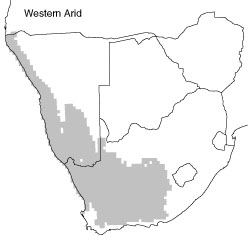
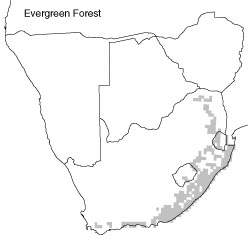
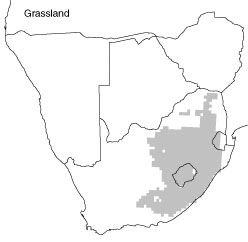
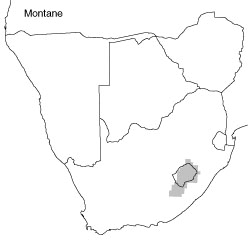
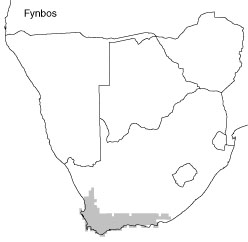
Fig. 2. Distribution of the Cape Francolin Francolinus capensis.

Fig. 3. Distribution of the Fairy Flycatcher Stenostira scita (the breeding distribution is hatched).

Fig. 4. Distribution of (a) the Thickbilled Lark Galerida magnirostris and (b) the Longbilled Lark Mirafra curvirostris.


Fig. 5. Distribution of Burchell’s Courser Cursorius rufus.

Fig. 6. Distribution of the Sicklewinged Chat Cercomela sinuata.

Fig. 7. Distribution of the Namaqua Warbler Phragmacia substriata.

Fig. 8. Distribution of the Lesser Doublecollared Sunbird Nectarinia chalybea.

Fig. 9. Distribution of the Blue Korhaan Eupodotis caerulescens.

Fig. 10. Distribution of Rudd’s Lark Heteromirafra ruddi.

Fig. 11. Distribution of Botha’s Lark Spizocorys fringillaris.

Fig. 12. Distribution of the Chorister Robin Cossypha dichroa.

Fig. 13. Distribution of Neergaard’s Sunbird Nectarinia neergaardi.

Fig. 14. Distribution of the Knysna Warbler Bradypterus sylvaticus.

Fig. 15. Distribution of the Olive Thrush Turdus olivaceus.

Fig. 16. Distribution of the (a) Cape Siskin Pseudochloroptila totta and (b) Drakensberg Siskin P. symonsi.
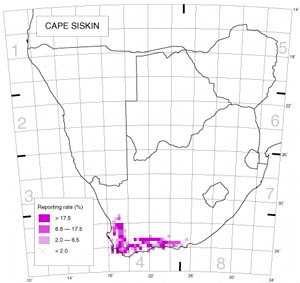
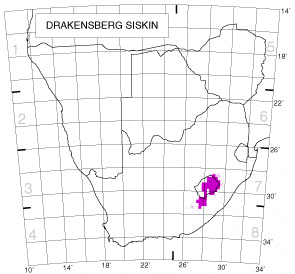
Fig. 17. Distribution of the (a) Cape Rockjumper Chaetops frenatus and (b) Orangebreasted Rockjumper C. aurantius.

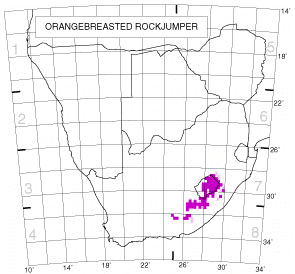
Fig. 18. Distribution of the (a) Cape Sugarbird Promerops cafer and (b) Gurney’s Sugarbird P. gurneyi.
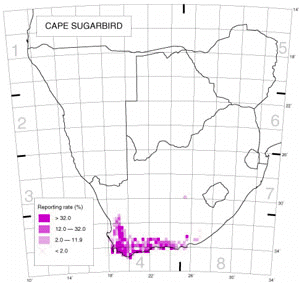
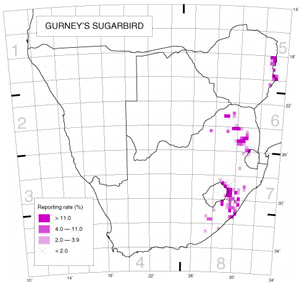
Fig. 19. Distribution of the Karoo Robin Erythropygia coryphaeus.

Appendix 1. The endemic birds of southern Africa, with their distributions and main habitats. Species marked with an asterisk (*) are endemic or nearly endemic to South Africa (including Lesotho). The conservation status, where relevant, is from Collar et al. (1994).
